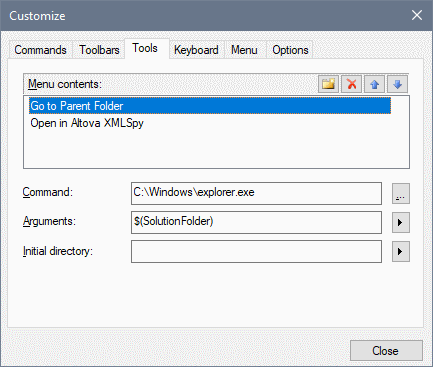Tools
The Tools tab allows you to set up commands to use external applications from within MobileTogether Designer. These commands will be added to the Tools | User-defined Tools menu. For example, the active file in MobileTogether Designer can be opened in an external application, such as XMLSpy, by clicking a command in the Tools | User-defined Tools menu that you created in this (the Tools) tab.

To set up a command to use an external application, do the following:
1.In the Menu Contents pane (see screenshot above), click the New icon in the title bar of the pane and, in the item line that is created, enter the name of the menu command you want. In the screenshot above, we have entered a menu command, Go to Parent Folder. We plan to use this command to open the parent folder of the active document in Windows Explorer. More commands can be added to the command list by clicking the New icon. In the screenshot above, for example, a command was created to open the active document in Altova's XMLSpy program. A command can be moved up or down the list relative to other commands by using the Move Item Up and Move Item Down icons. To delete a command, select it and click the Delete icon.
2.To associate an external application with a command, select the command in the Menu Contents pane. Then, in the Command field, enter the path to, or browse for, the executable file of the external application. In the screenshot above, the path to the Windows Explorer executable file has been entered in the Command field.
3.The argument to be passed to the external application is selected in the Arguments field (see screenshot above). The available arguments are displayed when you click the flyout button of the Arguments field and are described in the list below. When you select an argument, a code string for it is entered in the Arguments field. For example, in the screenshot above, the argument passed to Windows Explorer as the folder to open is the folder in which the active document—which must be a solution design—is located
4.If you wish to specify a current working directory (optional), enter it in the Initial Directory field.
5.Click Close to finish.
The user-defined command/s you created will appear in the Tools | User-defined Tools menu.
When you click a user-defined command (in the Tools | User-defined Tools menu) that you created, the action you associated with the command will be executed. The command example shown in the screenshot above does the following: It opens, in Windows Explorer, the folder in which the active solution is located. The Open in Altova XMLSpy command opens the active document in XMLSpy. The argument passed to XMLSpy is not the path to the parent folder, but the path to the active document.
Arguments
The Arguments field specifies the argument to be passed to the external application command. The following arguments are available.
•Solution File Name: The name of the active solution design file.
•Solution File Path: The path to the active solution design file, including the name of the active file.
•Solution Folder: The parent folder of the active solution design file.
•Temporary Folder: The path to the Windows system folder that is used to store temporary files. On Windows.
Initial directory
The Initial Directory entry is optional. It sets the initial directory for the command that is created.